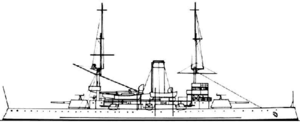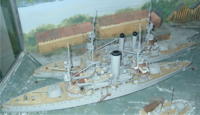HNoMS Harald Haarfagre
  Plans of the Tordenskjold-class coastal defense ships. Note heavy guns in forward and aft turret, and secondary armament in central battery. Plans of the Tordenskjold-class coastal defense ships. Note heavy guns in forward and aft turret, and secondary armament in central battery.
 Harald Haarfagre in drydock at Karljohansvern naval base. | |
| History | |
|---|---|
| Name | Harald Haarfagre |
| Namesake | Harald I of Norway |
| Ordered | 1896 |
| Laid down | 1897 |
| Launched | 4 January 1897 |
| Commissioned | 21 March 1898 |
| Captured | by the Germans in 1940 |
| Name | Thetis |
| Acquired | 1940 |
| Fate | Handed back to Norway after VE Day |
| Name | Harald Haarfagre |
| Acquired | 1945 |
| Fate | Scrapped 1948 |
| General characteristics as built | |
| Class and type | Tordenskjold-class coastal defence ship |
| Displacement | 3,858 long tons (3,920 t) |
| Length | 92.66 m (304 ft 0 in) |
| Beam | 14.78 m (48 ft 6 in) |
| Draught | 5.38 m (17 ft 8 in) |
| Propulsion | Coal-fired boilers, reciprocating steam engines, 4,500 hp (3,356 kW) |
| Speed | 16.9 knots (31.3 km/h; 19.4 mph) |
| Complement | 245 |
| Armament |
|
| Armour | |
| General characteristics after German rebuild | |
| Displacement | 3,858 long tons (3,920 t) |
| Length | 92.66 m (304 ft 0 in) |
| Beam | 14.78 m (48 ft 6 in) |
| Draught | 5.38 m (17 ft 8 in) |
| Propulsion | Coal-fired reciprocating steam engines, 4,500 hp (3,356 kW) |
| Speed | 16.9 knots (31.3 km/h; 19.4 mph) |
| Complement | 245 |
| Armament |
|
| Armour | |
HNoMS Harald Haarfagre, known locally as Panserskipet Harald Haarfagre, was a Norwegian coastal defence ship. She, her sister ship Tordenskjold and the slightly newer Eidsvold class were built as part of the general rearmament in the time leading up to the events in 1905. Harald Haarfagre remained an important vessel in the Royal Norwegian Navy until she was considered unfit for war in the mid-1930s.
Description

Built at Elswick[2] and nearly identical to her sister ship Tordenskjold, Harald Haarfagre was named after Harald I of Norway, known as "Harald Fairhair" in English, the semi-mythical first king of a united Norway. Built as a typical pre-dreadnought battleship on a smaller scale, she carried guns of a wide range of calibers: two 8.2-inch guns in barbettes, six 4.7-inch, six 3-inch, and six smaller quick-firing guns. The ship could manage a speed of over seventeen knots. Protected by belt armor of seven inches thickness, the ship also featured gun barbettes with nearly eight inches of steel armor and an armored deck.[3]
Service history and fate
A vital part of the Royal Norwegian Navy, Harald Haarfagre performed ordinary duties until she was considered "unfit for war" in the mid-1930s and disarmed. After the German invasion of Norway, she was seized by the Germans and rebuilt as a floating flak battery under the name Thetis. After the war Harald Haarfagre was used briefly as a floating barracks, and for transporting German POWs, before she was sold for scrapping in 1948.
It was intended to augment the Norwegian Panserskip fleet with the two ships of the Bjørgvin class, ordered in 1912, but after these were compulsorily purchased by the Royal Navy at the outbreak of the First World War, the Tordenskjold class and the slightly newer, two ship, Eidsvold class remained in service the Norwegian navy long after they were obsolete due to a lack of suitable replacements.
Today the name KNM Harald Haarfagre is used on the Royal Norwegian Navy and Royal Norwegian Air Force Basic Training Establishment, located in Madla, Stavanger.
Footnotes
- ^ Abelsen, Frank (1986). Norwegian naval ships 1939-1945 (in Norwegian and English). Oslo: Sem & Stenersen AS. p. 289. ISBN 82-7046-050-8.
- ^ Keltie, J.S., ed. (1900). The Statesman's Year Book: Statistical and Historical Annual of the States of the World for the Year 1900. New York: MacMillan. p. 1066 – via Google Books.
- ^ Keltie 1900, p. 1066.
Bibliography
- Dodson, Aidan & Nottlemann, Dirk (2023). "The German Flak Ships, Part I: The German and ex-Norwegian Hulls". In Jordan, John (ed.). Warship 2023. Oxford: Osprey Publishing. pp. 112–127. ISBN 978-1-4728-5713-2.
